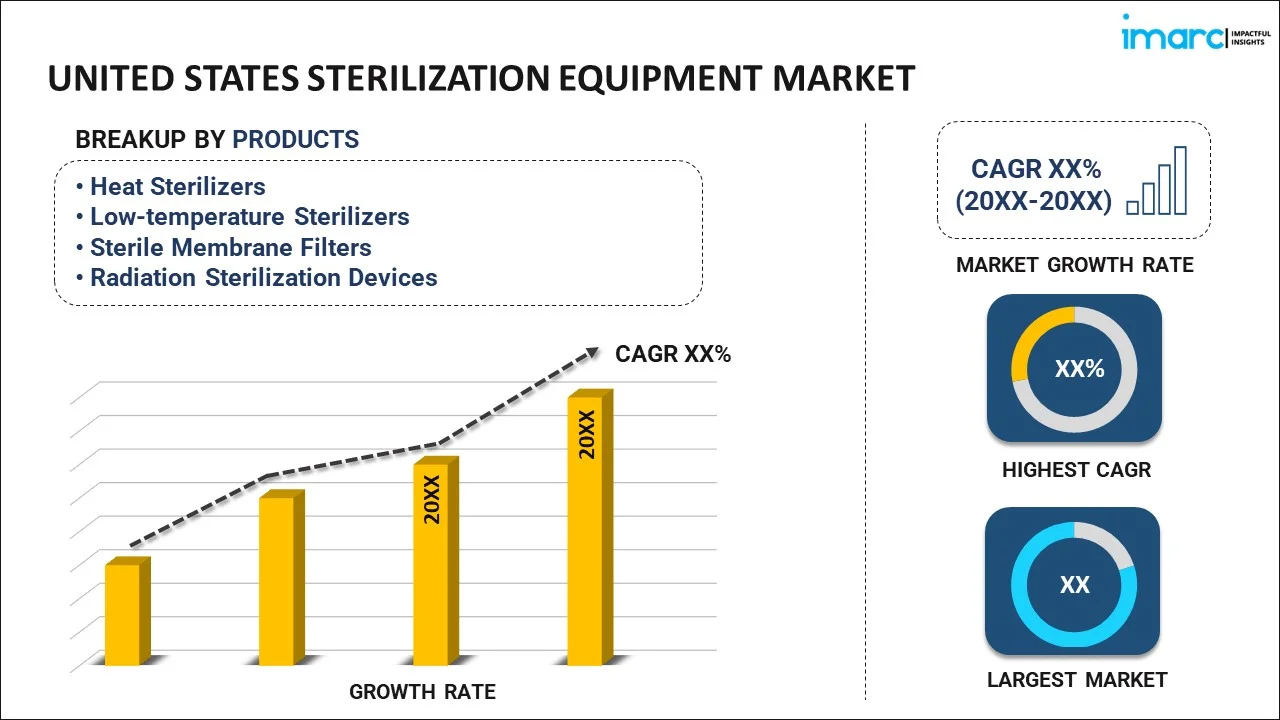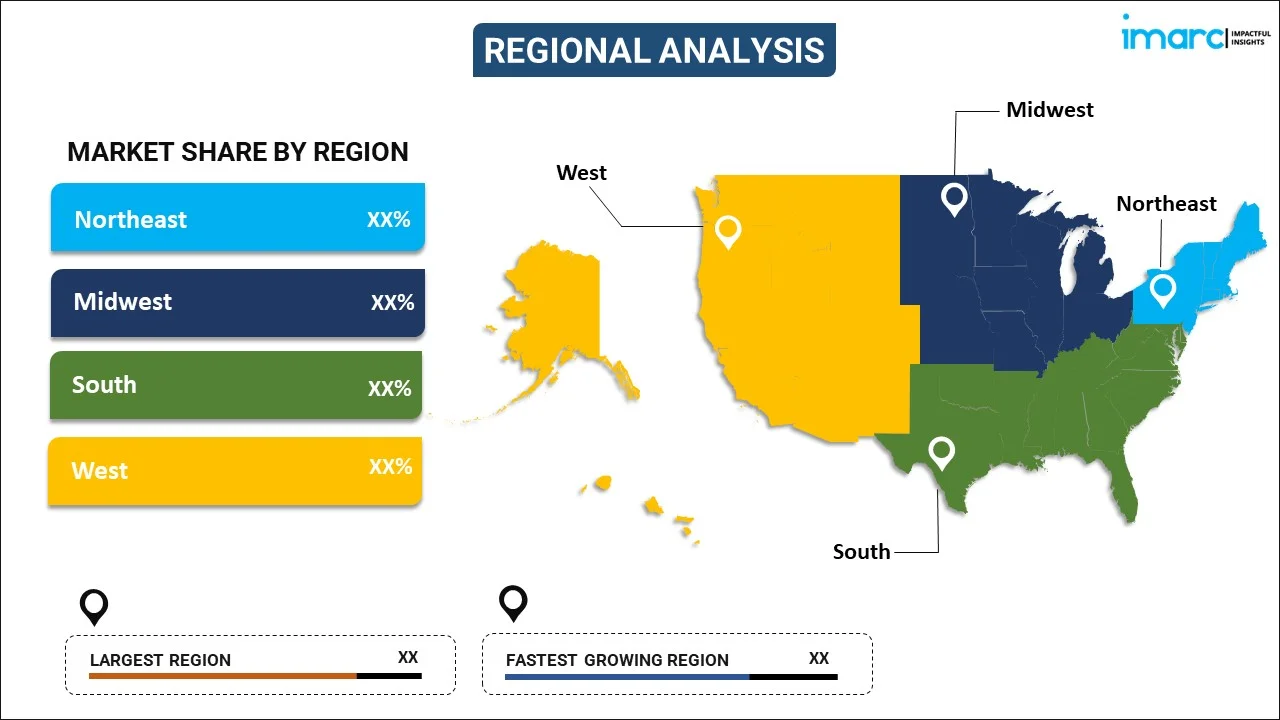
United States Sterilization Equipment Market Report by Product (Heat Sterilizers, Low-temperature Sterilizers, Sterile Membrane Filters, Radiation Sterilization Devices), End User (Hospitals and Clinics, Medical Device Companies, Pharmaceutical Companies, Food and Beverages Industry, and Others), and Region 2024-2032
Market Overview:
The United States sterilization equipment market size is projected to exhibit a growth rate (CAGR) of 4.60% during 2024-2032. The increasing demand for effective infection control and aseptic processing in the healthcare industry, the growing awareness of the importance of infection prevention and control, the rising healthcare expenditure, and the rapid expansion of pharmaceutical and biotechnology sectors are some of the factors propelling the market.
|
Report Attribute
|
Key Statistics
|
|---|---|
|
Base Year
|
2023 |
|
Forecast Years
|
2024-2032
|
|
Historical Years
|
2018-2023
|
| Market Growth Rate (2024-2032) | 4.60% |
Sterilization equipment refers to a diverse range of devices and systems designed to eliminate or inactivate microorganisms such as bacteria, viruses, fungi, and spores, ensuring the destruction of all forms of microbial life. The primary objective of sterilization is to create aseptic conditions in various settings, including healthcare facilities, laboratories, pharmaceutical manufacturing, and food processing industries. These devices play a crucial role in preventing the transmission of infections and maintaining the sterility of medical instruments, equipment, and supplies. Sterilization is vital in healthcare settings to safeguard patients and healthcare professionals from the risks of contamination during surgical procedures, medical treatments, and diagnostic interventions. In healthcare, sterilization equipment encompasses autoclaves, sterilization trays, ethylene oxide chambers, and various other devices that facilitate the decontamination and sterilization of medical instruments and equipment. In pharmaceutical and biotechnology industries, sterilization equipment is used to ensure the purity of drugs, vaccines, and other pharmaceutical products.
United States Sterilization Equipment Market Trends:
The market in the United States is majorly driven by the nation's commitment to healthcare quality. In line with this, the rising healthcare expenditure contributes significantly to the demand for advanced sterilization equipment in hospitals, clinics, and other healthcare facilities. The emphasis on patient safety and infection control encourages investments in cutting-edge sterilization technologies are also catalyzing the market across the country. Furthermore, the rising need to meet and exceed these regulatory requirements propels the adoption of state-of-the-art sterilization equipment that ensures a high level of efficacy and reliability in eliminating pathogens, thereby propelling the market. Besides this, the rapid technological advancements in sterilization equipment such as low-temperature sterilization methods, and advanced monitoring and control systems are also contributing to the market growth. Numerous innovations such as the integration of artificial intelligence (AI) and the Internet of Things (IoT) are leading to the development of more user-friendly sterilization solutions. This is resulting in higher product sales across the country. Moreover, the global COVID-19 pandemic has underscored the critical importance of infection control measures in healthcare settings. The heightened awareness of infection risks has accelerated the demand to maintain aseptic conditions and minimize the spread of infectious diseases. This, in turn, is acting as a significant growth inducing factor for the market. Healthcare facilities across the U.S. are investing in advanced sterilization technologies to enhance preparedness for pandemics and other health crises, bolstering the market. Additionally, considerable growth in the pharmaceutical and biotechnology industries which are also key contributors to the U.S. economy, is providing an impetus to the market.
United States Sterilization Equipment Market Segmentation:
IMARC Group provides an analysis of the key trends in each segment of the market, along with forecasts at the country level for 2024-2032. Our report has categorized the market based on product and end user.
Product Insights:

- Heat Sterilizers
- Depyrogenation Oven
- Steam Autoclaves
- Low-temperature Sterilizers
- Ethylene Oxide Sterilizers
- Hydrogen Peroxide Sterilizers
- Others
- Sterile Membrane Filters
- Radiation Sterilization Devices
- Electron Beams
- Gamma Rays
- Others
The report has provided a detailed breakup and analysis of the market based on the product. This includes heat sterilizers (depyrogenation oven and steam autoclaves), low-temperature sterilizers (ethylene oxide sterilizers, hydrogen peroxide sterilizers, and others), sterile membrane filters, and radiation sterilization devices (electron beams, gamma rays, and others).
End User Insights:
- Hospitals and Clinics
- Medical Device Companies
- Pharmaceutical Companies
- Food and Beverages Industry
- Others
A detailed breakup and analysis of the market based on the end user have also been provided in the report. This includes hospitals and clinics, medical device companies, pharmaceutical companies, food and beverages industry, and others.
Regional Insights:

- Northeast
- Midwest
- South
- West
The report has also provided a comprehensive analysis of all the major regional markets, which include Northeast, Midwest, South, and West.
Competitive Landscape:
The market research report has also provided a comprehensive analysis of the competitive landscape in the market. Competitive analysis such as market structure, key player positioning, top winning strategies, competitive dashboard, and company evaluation quadrant has been covered in the report. Also, detailed profiles of all major companies have been provided. Some of the key players include:
- 3M Company
- Belimed, Inc.
- Getinge AB
- Sotera Health
- Steris plc
(Please note that this is only a partial list of the key players, and the complete list is provided in the report.)
United States Sterilization Equipment Market Report Coverage:
| Report Features | Details |
|---|---|
| Base Year of the Analysis | 2023 |
| Historical Period | 2018-2023 |
| Forecast Period | 2024-2032 |
| Units | US$ Million |
| Scope of the Report | Exploration of Historical and Forecast Trends, Industry Catalysts and Challenges, Segment-Wise Historical and Predictive Market Assessment:
|
| Products Covered |
|
| End Users Covered | Hospitals and Clinics, Medical Device Companies, Pharmaceutical Companies, Food and Beverages Industry, Others |
| Regions Covered | Northeast, Midwest, South, West |
| Companies Covered | 3M Company, Belimed, Inc., Getinge AB, Sotera Health, Steris plc, etc. (Please note that this is only a partial list of the key players, and the complete list is provided in the report.) |
| Customization Scope | 10% Free Customization |
| Report Price and Purchase Option | Single User License: US$ 3699 Five User License: US$ 4699 Corporate License: US$ 5699 |
|
Post-Sale Analyst Support |
10-12 Weeks |
| Delivery Format | PDF and Excel through Email (We can also provide the editable version of the report in PPT/Word format on special request) |
Key Questions Answered in This Report:
- How has the United States sterilization equipment market performed so far and how will it perform in the coming years?
- What has been the impact of COVID-19 on the United States sterilization equipment market?
- What is the breakup of the United States sterilization equipment market on the basis of product?
- What is the breakup of the United States sterilization equipment market on the basis of end user?
- What are the various stages in the value chain of the United States sterilization equipment market?
- What are the key driving factors and challenges in the United States sterilization equipment?
- What is the structure of the United States sterilization equipment market and who are the key players?
- What is the degree of competition in the United States sterilization equipment market?
Key Benefits for Stakeholders:
- IMARC’s industry report offers a comprehensive quantitative analysis of various market segments, historical and current market trends, market forecasts, and dynamics of the United States sterilization equipment market from 2018-2032.
- The research report provides the latest information on the market drivers, challenges, and opportunities in the United States sterilization equipment market.
- Porter's five forces analysis assist stakeholders in assessing the impact of new entrants, competitive rivalry, supplier power, buyer power, and the threat of substitution. It helps stakeholders to analyze the level of competition within the United States sterilization equipment industry and its attractiveness.
- Competitive landscape allows stakeholders to understand their competitive environment and provides an insight into the current positions of key players in the market.
Need more help?
- Speak to our experienced analysts for insights on the current market scenarios.
- Include additional segments and countries to customize the report as per your requirement.
- Gain an unparalleled competitive advantage in your domain by understanding how to utilize the report and positively impacting your operations and revenue.
- For further assistance, please connect with our analysts.
 Inquire Before Buying
Inquire Before Buying
 Speak to an Analyst
Speak to an Analyst
 Request Brochure
Request Brochure
 Request Customization
Request Customization




.webp)




.webp)












